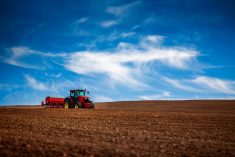Recent tax interpretations have reaffirmed that most retired farmers can cash rent without jeopardizing their estate and succession plans. That’s taken the wind out of crop-share agreements, but it has also created an opportunity for farmers and landlords to look at newer and better ways to establish fair rental rates.
A generation ago, crop-share agreements made up 40 per cent of land rentals. “The rationale for that was a lot of landlords were retired farmers and they wanted to retain their active farming status,” says Merle Good, provincial tax specialist with Alberta Agriculture based in Olds.
Read Also

Are you ready for farm succession?
What motivates some farmers to make a succession plan while others don’t seem worried.
“On the tax side, they wanted to look like an active farmer by having income and expenses,” Good says. “They also wanted to qualify for the rollover provision.”
Changes to the income tax act a few years ago loosened up the criteria for the family farm rollover provision and the $750,000 capital gains exemption. Good says a recent (late 2010) technical ruling on the income tax act has clarified the rollover rules so that as long as the land has been actively farmed for more time than it has been rented out on a cash rental basis, your land will qualify for the rollover.
Importantly, the owner and the user can be two different people. “What that means is the owner could be one person, but the user could be a parent or grandparent,” Good says. “So if Dad farmed it for 30 years and Grandpa for the 30 years before that, you have a 60-year window. You can cash rent it a long time and still qualify.”
“On the tenant’s side, they tend to like a cash rent,” Good adds. “It’s a set number, they understand it… On the negative side, if they have too high a cash rent, their risks go up.”
So the question is: how do you know what’s a fair rent?
Option 1:Percentage of gross value
Do some research for your local area. Look back at the last five to 10 years of cash rents in your area and estimate what percentage they were of the market value of the crop that the land grew.
In most areas, Good thinks, rent will be 20 to 25 per cent of gross returns. In his area of central Alberta, gross returns over the last three years have been about $275 per acre, and rent has been about $55, or right on the 20 per cent.
So for next year, look at probable yields time price, and negotiate toward a rent that’s 20 per cent of your total.
“Doing that research gives you a feel for what rents are, which gives you a starting point if you do want to come up with a formula for a flexible cash rent,” Cood says.
Option 2:Percentage of crop insurance
Similar to Option 1 is to compare historic rents against crop insurance coverage. “In our area, if $275 is the actual gross, you might only be able to insure $200,” Good says. “To get back to $55 per acre, that would be 27.5 per cent. So another way to rent land might be to agree on a figure — say 27 per cent of crop insurance coverage — based on an agreed rotation.”
“If prices go up, the landlord gets a higher payment. If commodities go down, he gets a little less.”
Especially when the land gets left to non-farming children, the tenant could send the owner a fax of the area average coverage and say, “This is your 27 per cent. That’s what I owe you.”
“You could get more complicated and establish a floor — say a minimum of $35 per acre no matter what happens — to offer protection to the landlord. Then the rent can go up from there,” says Good.
“Even for farmers that don’t ever buy crop insurance, there’s still an area average that can be used as a base to start from.”
Option 3:Based on price
For those who don’t like gross revenue, a price option might work, as long as you have a futures or a marketing board reference point you can agree to, such as Canadian Wheat Board numbers. “If your base rent is $40 per acre and the PRO goes from $5 per bushel to $6 from one year to the next, then your rent goes up by six divided by five, or 20 per cent,” Good says. “If it goes up this year you get paid more rent, if it goes down next year you get less.”
“But it’s indexed, so if the price goes up 30 per cent on a $40 per acre base, that’s a $12 per acre increase. It’s a huge increase to the landlord, but it’s not going to break the tenant”
Option 4:One commodity, one yield
Good calls this the “one commodity, one yield” approach and says it helps give the landlord confidence when the farmer goes to other crops. For instance, if barley is big in an area, the landlord and farmer might decide that 20 bushels per acre of barley is a fair rental return.
“They use a blended price of 50 per cent feed and 50 per cent malt, then pay that out on the 20 bushels per acre,” Good says.
“If barley goes up to $4 per bushel, the landlord gets $80 per acre, if it goes down to $3 per bushel it’s $60 per acre. It isn’t indexed — it’s a true gross margin percentage based on price only, not yield.”
Good says this arrangement allows the tenant to grow any crop on the land, but the landlord still gets paid on how barley performs.
Option 5:Production joint ventures
Most farm leases now are cash rent. There are few crop shares left. But there are still situations where the landowner wants to be considered an active farmer.
“Where this comes into play is with landlords that don’t meet the test,” Good says. “If they don’t meet the rollover rules or gross revenue test, they need another option.”
To develop a Production Joint Venture agreement, Good says lawyers and accountants are using business structures borrowed from the oil and gas industry. In many cases, the operator of a well isn’t the owner. There can be six junior oil companies owning a piece of one well, each with their own roles and responsibilities.
“Canada Revenue Agency says crop share will not qualify as actively farming. So we’ve come up with a concept called a ‘Production Joint Venture,’” says Good.
“In order to be active in any business, you have to have risk and participate in the management, but you don’t have to do all the work. Revenue Canada says if you get all your land custom farmed, you qualify as a farmer. But then you have all the risk.”
“A Production Joint Venture says instead of doing the custom farming routine, we look at an oil-style joint venture. The landowner provides some input costs, land and some management, while the tenant provides equipment, management and marketing skills.”
For these leases, says Good, it’s critical to get legal and accounting advice.
Bonus option:Rolling lease
One aspect of renting land that can be an issue is renewal time. For example, you may have a three-year lease with your landlord. At the end of three years, you have to talk about renewal, rates and those kinds of things.
“If you’ve been remiss like a lot of young farmers, who don’t talk with their landlord enough, you get to that meeting, the landlord is mad about something and you lose the land. What the rolling lease does is get around this,” says Good.
“If you sign a three-year deal, every year, unless one partner approaches the other in writing about any issues, you simply add a year. So you always have a three-year lease. But the rate is set every second year. So an agreement set up in March 2011 goes to March 2014, but in March 2013, the rate can get reset.”
“The reason this rotational lease is so important now compared to 20 years ago is because of the huge difference in revenue on crop rotations, plus the input costs applied in the fall. If you put down anhydrous in the fall, or winter cereals, you have a big cost.”CG
———
“ If prices go up the landlord gets a higher payment. If commodities go down, he gets a little less. ”
— Merle Good














